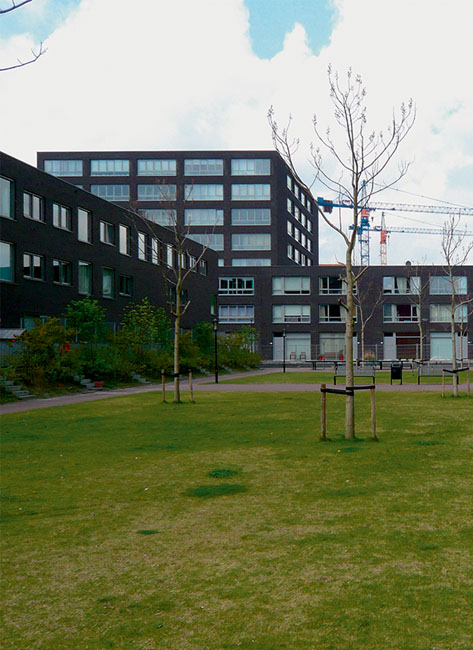IJburg blok 23 & 24 Amsterdam Architekten Cie., Dick van Gameren, VMX (blok 23) Meyer en Van Schooten, Claus en Kaan, ANA (blok 24)
Samenvatting
De uitbreidingswijk IJburg, aan de oostkant van Amsterdam, bestaat uit zeven kunstmatige eilanden. Eén daarvan, het grootste, is Haveneiland. De blokken op Haveneiland west zijn ontwikkeld door consortia van opdrachtgevers en ontwikkelaars/bouwers. Voor elk blok is een coördinerend architect aangesteld die samen met andere bureaus, ook de uitwerking voor zijn rekening neemt. Deze strategie bleek duur en tijdrovend, zodat in het later ontwikkelde Haveneiland oost gekozen is voor één uitvoerende architect per blok. Na de economische recessie van begin van de 21e eeuw moest de ontwikkeling van Haveneiland west immers drastisch worden bijgesteld.
Het stedenbouwkundig plan voor IJburg is gemaakt door Felix Claus, Frits van Dongen en Ton Schaap. Dit voorziet op Haveneiland in een raster van straten, waartussen rechthoekige blokken ontstaan met een lengte van 175 m en een breedte die varieert van 90 tot 70 m. Het raster van blokken en straten is doorsneden door een gracht.
Wezenlijk kenmerk van de grondlegger is dat het binnenterrein van de blokken tot het publieke domein behoort. De organisatie van de binnengebieden is een primaire ontwerpopgave. De bouwblokken moeten dus geopend zijn, de binnenhoven verbonden met de omliggende straten. De voorgeschreven woningdichtheid is zo hoog dat het binnengebied van de blokken voor een deel bebouwd moet worden. Hierdoor ontstaan binnen één blok gevarieerde en gedifferentieerde publieke ruimten. Het oorspronkelijke idee om de binnenterreinen ’s avonds af te sluiten, stuitte op bezwaren van ontwikkelaars die problemen voorzagen met het beheer.
Rond alle blokken (behalve aan de IJburglaan) is een strook van 1,2 m voorzien, die door de bewoners kan worden gebruikt om de stap van publiek (de straat) naar privé (de woning) minder abrupt te maken. Het parkeren dient grotendeels op eigen terrein te gebeuren. Vrijwel overal resulteert dit in parkeerkelders. Een opvallende uitzondering vormt het blok van VMX, dat over een autolift beschikt.



